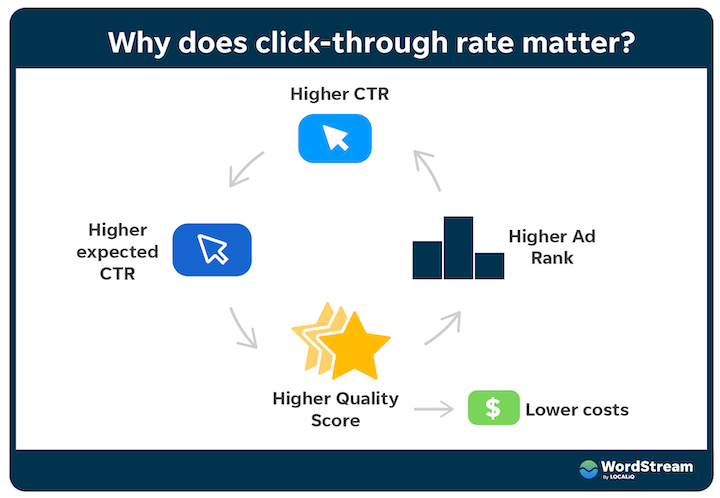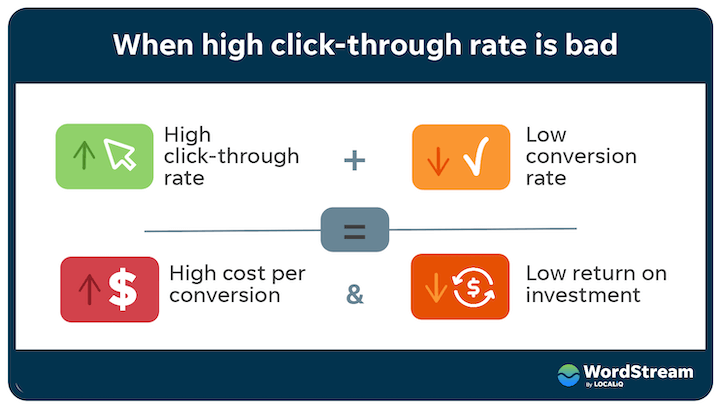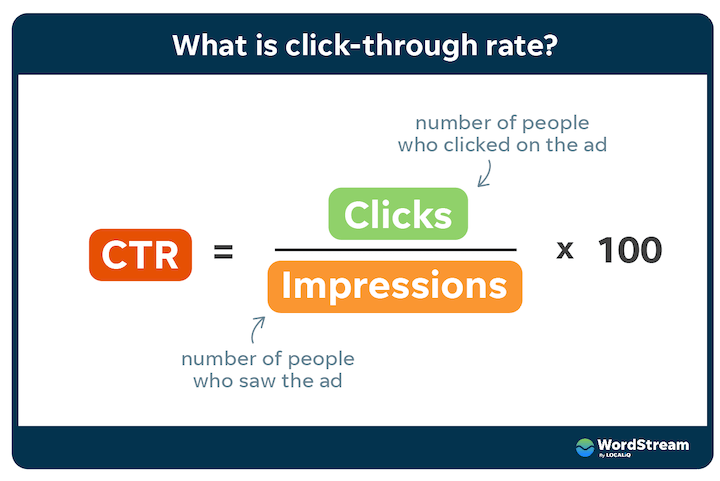Uncover the secrets of Click-Through Rates (CTR) and discover the key strategies for boosting engagement and driving conversions.

Image courtesy of via DALL-E 3
Table of Contents
Welcome to our guide on Click-Through Rate (CTR)! In this article, we will explore what CTR is, why it matters, and how you can improve it for your website or ads. Let’s dive in and discover the importance of this essential metric.
What is CTR?
CTR, short for Click-Through Rate, is a crucial metric that measures the percentage of people who click on a link after seeing it. Imagine you have an ad or a website link, and CTR tells you how many people actually clicked on it after viewing it. It helps determine the effectiveness of your content and marketing strategies.
Why CTR Matters
Having a high CTR is vital because it indicates that your content is engaging and appealing to your audience. A higher CTR can lead to increased website traffic, more interactions with your content, and ultimately better results for your business. It’s like having a lot of people interested in what you have to offer!
How to Calculate CTR
Calculating Click-Through Rate (CTR) might sound like a complex task, but it’s actually quite simple once you break it down. Let’s dive into the formula and see how you can figure out this important metric for your website or ads.
CTR Formula
The formula for CTR is straightforward: you take the number of clicks your link receives and divide it by the number of times the link was shown (impressions), then multiply that by 100 to get the percentage.
Mathematically, the formula looks like this: CTR = (Clicks ÷ Impressions) × 100.
Example Calculation
Let’s say your ad was shown 1,000 times (impressions) and received 100 clicks. To calculate the CTR, you would plug these values into the formula: CTR = (100 ÷ 1000) × 100 = 10%.
So, in this example, your CTR would be 10%, meaning that 10% of the people who saw your ad clicked on it. The higher the percentage, the better your CTR, indicating that more people are engaging with your content.
Improving Your CTR
So, you now know what Click-Through Rate (CTR) is and why it’s crucial for websites and ads. But how can you actually improve your CTR? Let’s dive into some practical tips and strategies that can help you boost those click numbers!
Use Eye-Catching Titles
One of the most effective ways to improve your CTR is by using eye-catching titles. When your title is exciting and interesting, it grabs the viewer’s attention and entices them to click on your link. Think about what would make you click on a link when scrolling through a page – that’s the kind of title you want to create!
Add Clear Call-to-Actions
Another essential strategy to improve your CTR is by incorporating clear Call-to-Actions (CTAs). A CTA prompts the viewer to take a specific action, such as “Learn More” or “Sign Up Now.” By providing clear instructions on what you want the viewer to do next, you make it easier for them to engage with your content and ultimately increase your CTR.
Understanding and Testing
A/B testing is a method used to compare two versions of a webpage or advertisement to see which one performs better. In A/B testing, one version (A) is the control, while the other version (B) has one element changed, such as a different headline or image. By showing these versions to different groups of users and comparing their performance, marketers can determine which version drives a higher click-through rate (CTR).

Image courtesy of www.wordstream.com via Google Images
How to Conduct A/B Tests
Running A/B tests to improve CTR involves a simple process. First, identify the element you want to test, such as a headline, image, or call-to-action button. Create two versions of the element, with only one thing changed between them. Then, randomly show these versions to different users and track their interactions. Analyze the results to see which version resulted in a higher CTR.
Using Analytics Tools
Analytics tools play a crucial role in tracking and analyzing Click-Through Rate (CTR) data. They provide valuable insights into user behavior, helping website owners and advertisers make informed decisions to improve their CTR. Let’s explore how these tools work and how you can use them effectively.
Popular Tools
One of the most popular analytics tools for tracking CTR is Google Analytics. This powerful tool offers a wide range of features to monitor website traffic, analyze user interactions, and evaluate the effectiveness of marketing campaigns. Other tools like SEMrush, Ahrefs, and Moz also provide valuable data on CTR performance.
How to Use Tools
Using analytics tools to track CTR involves setting up specific goals, tracking key metrics, and analyzing the data to identify trends. With Google Analytics, for example, you can create custom reports to monitor CTR on different pages of your website or specific ad campaigns. By interpreting this data, you can determine which strategies are working well and which ones need improvement.
Common Mistakes to Avoid
One common mistake that can harm your Click-Through Rate (CTR) is ignoring mobile users. With the majority of internet users browsing on smartphones and tablets, it’s crucial to optimize your website and ads for mobile devices. Ensure that your content is responsive and looks good on smaller screens to provide a seamless experience for all users.

Image courtesy of www.wordstream.com via Google Images
Using Misleading Titles
Another pitfall to avoid is using misleading titles to attract clicks. While clickbait titles may generate initial interest, they ultimately lead to high bounce rates and a negative impact on your CTR. Instead, focus on creating honest and compelling titles that accurately reflect the content of your links. By being transparent with your audience, you can build trust and encourage more clicks in the long run.
Analyzing Competitors
When looking to improve your Click-Through Rate (CTR), it’s crucial to start by identifying who your main competitors are. These are the websites or ads that are targeting a similar audience or offering similar products or services. By understanding who your competitors are, you can gain insights into their strategies and see what is working for them.
Learn from Competitors
Once you have identified your top competitors, it’s time to dig deeper and learn from their strategies. Look at their ad copy, titles, images, and call-to-actions. Analyze the language they use, the tone of voice, and the overall design of their ads or websites. Pay attention to the elements that seem to be attracting clicks and engagement from the audience.
Keeping Up with Trends
It’s essential to stay updated with the latest trends in Click-Through Rate (CTR) and digital marketing. By reading blogs, joining forums, and following social media, you can keep abreast of the newest developments in the field. Industry news can give you insights into what strategies are working best and what changes are on the horizon.

Image courtesy of www.wordstream.com via Google Images
Adapt to Changes
As user behavior and technology evolve, it’s crucial to adapt your CTR strategies accordingly. What worked yesterday may not work tomorrow, so being flexible and open to change is key. By staying nimble and adjusting your approach as needed, you can ensure that your CTR remains high and your digital marketing efforts stay effective.
Conclusion
In conclusion, Click-Through Rate (CTR) is a crucial metric for websites and ads. It indicates the percentage of people who click on a link after seeing it, which in turn can lead to increased website traffic and engagement. By understanding CTR and implementing strategies to improve it, you can enhance the performance of your online content and campaigns.
Review Key Takeaways
Remember, a high CTR is desirable as it signifies that your content is resonating with your audience. To improve your CTR, use eye-catching titles and clear call-to-actions. Additionally, testing different strategies through A/B testing and utilizing analytics tools like Google Analytics can provide valuable insights to optimize your CTR further.
Want to turn these SEO insights into real results? Seorocket is an all-in-one AI SEO solution that uses the power of AI to analyze your competition and craft high-ranking content.
Seorocket offers a suite of powerful tools, including a Keyword Researcher to find the most profitable keywords, an AI Writer to generate unique and Google-friendly content, and an Automatic Publisher to schedule and publish your content directly to your website. Plus, you’ll get real-time performance tracking so you can see exactly what’s working and make adjustments as needed.
Stop just reading about SEO – take action with Seorocket and skyrocket your search rankings today. Sign up for a free trial and see the difference Seorocket can make for your website!
FAQs
What is a good CTR?
A good Click-Through Rate (CTR) is typically considered to be around 2-5%. This means that out of every 100 people who see your ad or link, 2-5 of them click on it. However, what is considered a good CTR can vary depending on the industry you are in. Some industries naturally have higher average CTRs than others. So, it’s essential to compare your CTR to industry benchmarks to get a clearer picture of how well you are performing.
How often should I check my CTR?
Checking your CTR regularly is crucial to understanding how well your ads or links are performing and making any necessary adjustments. It’s recommended to monitor your CTR at least once a week to track any changes. By keeping a close eye on your CTR, you can identify trends, see what strategies are working, and make timely improvements to boost your click-through rates.







